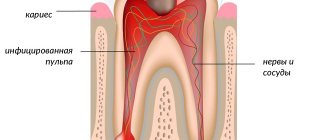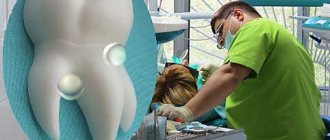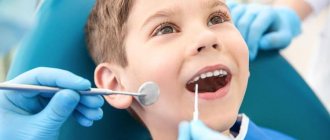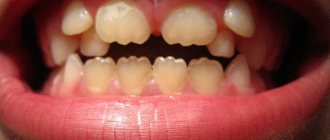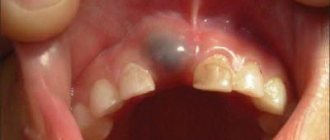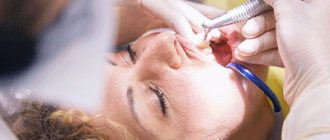Until the age of 7, caries is observed in 80% of cases. This disease begins to develop as soon as teeth erupt. Many parents deliberately do not notice this problem. But practice shows that both baby and permanent teeth need treatment. If the situation is neglected, you can get a purulent infection, pulpitis and other equally serious problems. In addition, treating caries does not necessarily mean drilling. Today, low-penetration techniques have been developed for children. This is fluoridation, silvering, infiltration.
Rules for the treatment of baby teeth
- Anesthesia takes place in 2 stages. This is necessary so that the baby does not feel anything and is not afraid. First, a gel or spray and lidocaine are applied to the gums. Only then is the injection given. For this, the finest needles are used.
- Tissues affected by caries are carefully removed using a special hand tool.
- A safe concentration of anesthetic in the drug is maintained. For Lidocaine it is 2%, for Articaine – 4%. The amount of the drug is selected depending on the weight of the child. Apply from ½ to 1/6 of the standard adult dose. Anesthetics containing adrenaline should not be used for children under 4 years of age.
- Treatment of caries is carried out in sessions. Each should last no more than 30 minutes. Otherwise, the baby will get tired and become capricious.
- Filling materials are used that can be applied in one go. They contain fluoride and other minerals to strengthen teeth.
“Permanent 6th teeth erupt in children aged 5-6 years and, as a rule, are affected by caries first. Teach children how to use toothbrushes and toothpastes correctly, which will prevent plaque from accumulating in deep fissures.”
Rita Martikovna Meliksetyan, Dentist therapist, orthodontist, pediatric dentist, 19 years of work experience
Why you shouldn’t be afraid to treat your child’s teeth
Dentists know about the structural features of baby teeth, so they always use modern painkillers when treating young patients. These products make the treatment painless and comfortable, helping the baby avoid stress.
Thus, in pediatric dentistry today the following anesthesia options are used:
- Local. An affordable and simple way to block the sensitivity of nerve endings. The baby is injected with an anesthetic, due to which the working area becomes completely insensitive. To prevent the small patient from experiencing pain during the injection, the gums are first treated with an anesthetic spray. So, step by step, the doctor ensures that the treatment of caries goes unnoticed for the child.
- Sedation. A progressive option for pain relief. According to its terms, sedative medications are given to the baby to inhale through an inhalation mask. As a result, the patient plunges into an intermediate state between sleep and wakefulness, does not resist the specialist, behaves calmly and does not experience pain.
- General anesthesia. Last resort. It is necessary only if the situation is very serious - the patient categorically refuses to open his mouth and sit still, and the oral disease progresses rapidly and requires emergency treatment. They also resort to anesthesia if the baby is intolerant to all available drugs for local anesthesia. You can’t just use this option for pain relief, as it has a lot of contraindications and side effects.
Parents don't need to worry. Local form of anesthesia is the most common. Usually it is enough to get the baby’s teeth in perfect order. All medications used by dentists when working with children are safe and highly effective. All you have to do is trust the doctor.
How is childhood caries diagnosed?
Tooth decay occurs much faster in children. This process takes several months. All due to weak enamel of baby teeth. They are permeated with many micropores through which bacteria penetrate. Therefore, you need to undergo a dental examination at least once every 3-4 months.
At different stages of caries, its symptoms differ:
- Initial stage. White spots appear on the tooth enamel, which then turn yellow and become rough. There is no pain, although the tooth may react to hot and cold. To eliminate initial damage, you do not need to drill the tooth. In such cases, it is possible to restore the enamel without filling.
- Middle stage. A “hole” is formed at the site of damage to the enamel. Food debris and softened dectin accumulate in it. In such cases, a cavity is formed and a filling is placed to prevent further decay.
- Deep stage. Not only the enamel is destroyed, but also the bone tissue of the tooth. The damage is noticeable to the naked eye. Deep caries can be cured with fillings, but sometimes even this does not help. In some cases, it is necessary to remove a baby tooth.
Diagnosis of carious lesions is carried out visually or using a special probe. If the “hole” is located in a remote place, an oral camera or x-ray is used. In the initial stages of caries, a special composition is used, which is applied to all teeth. It turns the affected areas pink or blue. This method has no side effects.
Is it possible to cure caries in a child without drilling? What methods are there?
It is possible if the carious cavity is at the initial stage.
- Remineralizing therapy.
- Treatment method with the Icon system.
- In some cases, we replace the drill with a RONDOflex device - this is an air-abrasive handpiece. Preparation occurs using a mixture of water jet and aluminum oxide powder. The treatment proceeds in a gentle manner and is not accompanied by noise, vibration, or unpleasant sensations.
Unfortunately, most often parents bring their child to the clinic when a tooth is already bothering him and the baby complains of discomfort or pain. Usually this is already the stage of pulpitis. In these cases, treatment without a drill is impossible.
IMPORTANT! I always recommend my patients to come for a preventive examination 2 times a year, even if there are no complaints. Often pathological processes in the tooth are asymptomatic.
Treatment of caries in early childhood
- Fluoridation. The second name of this method is remineralization. This is the saturation of the affected areas of enamel with minerals, its restoration. The tooth surface is treated with a special composition containing calcium, phosphorus, fluorine and other elements. The effect of this treatment lasts for about six months. Fluoridation is indicated for children from 6 years of age.
- Silvering. This method is outdated, but is still sometimes used. The surface of the tooth is coated with a 30% solution of silver nitrate, which destroys bacteria that cause caries. The procedure is absolutely painless. But after it the teeth become black, which can cause complexes in the child.
- Infiltration. A special gel is applied to the affected area of the tooth, which softens the tissue. Afterwards they are washed with an abrasive mixture. The area is then dried and covered with Icon Liquid Filling. The material hardens under a curing lamp.
- Ozone therapy. Ozone under pressure in a gaseous state is applied to the area of the tooth affected by caries. This does not cause any pain. The duration of the procedure is 10-20 seconds. Ozone destroys bacteria that cause tooth decay. After ozone therapy, tooth decay stops.
- Filling. The installation of fillings on baby teeth begins with the removal of dead tissue from the cavity. This is done with hand tools or a drill. The cavity is disinfected with a special composition and hermetically sealed. Upon completion, the surface of the filling is ground.
The filling material should be no harder than enamel. Otherwise, protrusions will form along the edges. Therefore, glass ionomer cements are used for children. They wear evenly and naturally together into enamel.
Some clinics use colored fillings for fillings. They are made from compomer and have no side effects.
How to relieve pain
The first help from you as parents in such situations is to reduce the pain in the child. Trying to cure any diseases of the mouth, gums and teeth at home is simply unsafe; it can lead to very serious consequences. But you can reduce the pain and calm the baby with the help of recommended medications, which it is advisable to always keep in your home medicine cabinet.
Children with toothache can only be given analgesics that are approved for their age. Such remedies can help stop a painful attack, relieve inflammation, and can remove swelling of the cheek and redness of the oral mucosa. You can use the help of such drugs at home, here are some of the effective ones:
- Dantinorm Baby (a remedy for reducing pain and other symptoms during teething);
- Dentinox (a drug for local use with anesthetic, antiseptic and anti-inflammatory effects);
- Kamistad (gel with active ingredients in the form of lidocaine and chamomile). An effective remedy against pain in teeth and gums;
- Children's Nurofen (proven remedy for inflammation and fever, toothache and swollen gums).
BE SURE to carefully read the instructions for any medicine and strictly follow the dosage regimen and age restrictions specified in the description.
How is caries of permanent teeth treated in children?
Caries on permanent teeth is treated as in adults. The main method is filling. Photocomposites are the most successful for sealing the affected cavity. These are materials that do not differ in color or texture from teeth. Filling takes place in several stages:
- Introduction of anesthesia.
- Removing dead tissue using a drill and cleaning the cavity.
- Rinsing the tooth with an antiseptic.
- Air drying.
- Application of phosphate cement insulating gasket.
- Filling with composite materials in several layers, each of which must be dried with a special lamp.
For shallow caries, infiltration, remineralization or ozone therapy can be used. Silver plating is contraindicated.
Anesthesia for the treatment of childhood caries
Local anesthesia. Used in the vast majority of cases. There are 2 types: application and injection anesthesia. The first does not involve an injection. The risk here is that the child may swallow saliva containing lidocaine. Injections are safer and more effective.
Anesthesia. Used if the child is restless or simply afraid to have their teeth treated. This method is common in the West. Many parents are afraid of memory impairment due to general anesthesia. However, this happens extremely rarely. In addition, general anesthesia becomes the only option when you need to fill several teeth at once in one trip to the dentist. After all, this can take 2 or more hours. Before general anesthesia is administered, the child must undergo the following tests:
- Blood biochemistry.
- General blood and urine analysis.
- Electrocardiography.
- Blood for sugar.
Before the introduction of general anesthesia, you cannot eat for 6 hours, and drink for 4 hours. The child is gently put to sleep using a sedative gas containing sevoflurane. To wake him up, it is enough to increase the oxygen supply. This can be done at any time. After recovery from anesthesia, all reflexes are restored within the first 15 minutes.
Opportunities of modern pediatric dentistry
Just recently, no one thought about the fact that a child’s teeth should be treated as painlessly as possible. Treatment for the baby should take place in a psychologically comfortable environment. That nothing bad will happen, he will cry and forget. This is why there are so many adults who are afraid of dentists. They go only when the teeth hurt so much that it is no longer possible to endure.
Now there are many specialized children's dental clinics that take into account the psychological and physiological characteristics of children. These dentists do not resemble hospitals. On the contrary, their interiors are decorated in a children's style. This creates a relaxing environment for kids. These clinics are staffed by dentists and paramedical personnel. They specialize in treating young patients and know their psychological characteristics. In these medical institutions, only modern, gentle methods of treating dental diseases are used, and modern anesthesia is used. If the baby is completely unable to withstand the treatment, it is carried out under anesthesia.
Complications of childhood caries
It is important to treat baby teeth. After all, deep caries can penetrate the tissue so much that it damages the permanent dentition. In addition, the condition of temporary teeth subsequently affects the child’s bite. Removal leads to abnormal growth of the jaw. As a result, permanent teeth may appear out of place. Because of this, the child will have to wear braces.
Deep caries leads to inflammation of the pulp, periodontitis, and the formation of basal cysts. Treating these problems is very difficult and painful. It requires root canal filling.
If periodontitis starts, it can cause an abscess and even osteomyelitis. This is already dangerous for the child's life.
Our patients
Patient recommendations
Akhmedkhanov Said Rashidovich
Dental surgeon, general dentist, implantologist, orthopedic dentist, dental therapist.
Make an appointment 8 (499) 520-98-70
Make an appointment
Recommendations from patient Alekseeva O.V.
Akhmedkhanov Said Rashidovich
Dental surgeon, general dentist, implantologist, orthopedic dentist, dental therapist.
Make an appointment 8 (499) 520-98-70
Make an appointment
Recommendations from patient Zolotareva S.V.
Akhmedkhanov Said Rashidovich
Dental surgeon, general dentist, implantologist, orthopedic dentist, dental therapist.
Make an appointment 8 (499) 520-98-70
Make an appointment
Recommendations from patient Vera
Akhmedkhanov Said Rashidovich
Dental surgeon, general dentist, implantologist, orthopedic dentist, dental therapist.
Make an appointment 8 (499) 520-98-70
Make an appointment
Recommendations from patient Mikhail Ivanovich
Akhmedkhanov Said Rashidovich
Dental surgeon, general dentist, implantologist, orthopedic dentist, dental therapist.
Make an appointment 8 (499) 520-98-70
Make an appointment
Collapse

